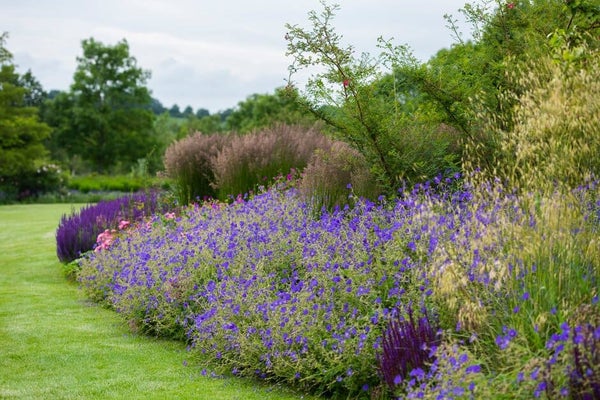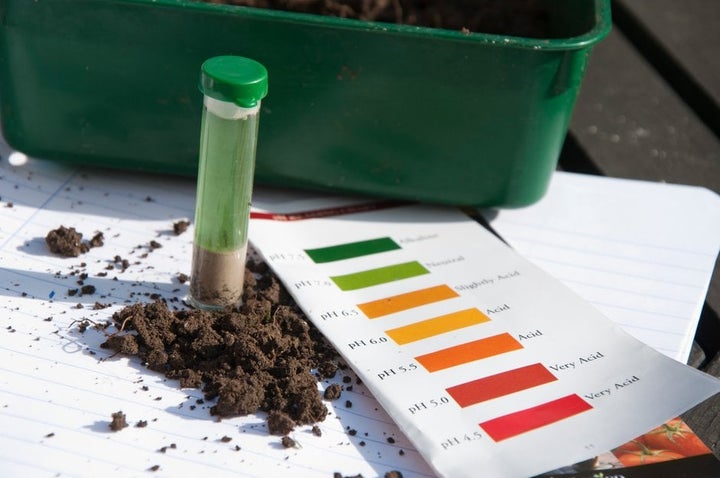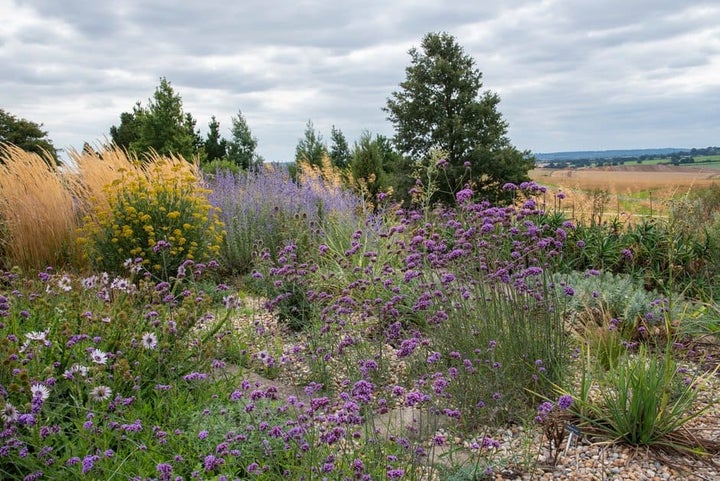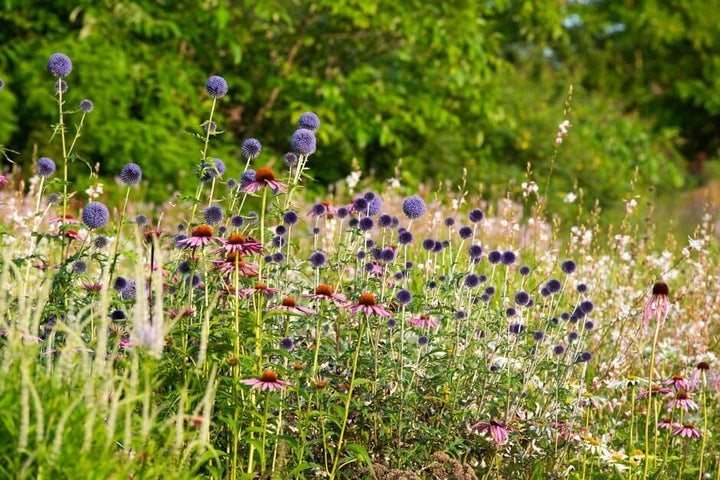
Quick facts
Planning a border can be done at any time of year; planting is best done in spring or autumn
Knowing your soil type is key to selecting plants that will thrive
Growing a range of plants, with something in flower every month of the year, benefits pollinators and provides interest year-round
Getting started – planning your border
A border is simply a defined area of planting, often used to edge a garden and separate the lawn from a boundary hedge or fence. It allows you to create attractive displays with different combinations of plants and helps to add colour and year-round interest to a garden.
Creating a border from scratch can seem daunting, but with a little planning it’s easy to create one that looks great, grows well and suits your needs. Understanding your garden’s growing conditions is key to this process, as it helps you choose plants that will grow well in the border. This principle of ‘right plant, right place’ makes your planting more climate resilient, reduces cost, waste and disappointment, while also benefitting wildlife and reducing the likelihood of plant health problems.
Our handy step-by-step guide below talks you through the practical and aesthetic factors to consider when planning your border.
What you’ll need to plan a border:
- A soil testing kit (optional)
- Tape measure or other means of measuring your border
- Pencil and paper for taking measurements and drawing a plan
- Gardening magazines, books, catalogues, websites and RHS Find a Plant for ideas on style and plant selection
- An image of the colour wheel
Top Tip
Choosing plants can be overwhelming (the RHS Plant Finder lists 69,000 plants!), so rather than feel restricted by your specific growing conditions, consider them a useful way to filter your choices.
How to plan a border in eight simple steps

- Know your soil This is fundamental to ensuring a successful border. See our advice page on soil types for help identifying whether you have clay, sand, silt, loam or chalk, and how best to work with it.
Soil type influences how quickly water drains, but other factors, such as levels of compaction and water table height, also affect drainage. See our advice pages on waterlogging and drainage for information on recognising and dealing with drainage issues. Knowing how free-draining your soil is helps to inform your plant selection – there are many drought-resistant plants and plants suited to wet soils.
Measure the pH level (acidity or alkalinity) of your soil with a simple testing kit (sold in many garden centres), or you could pay to have your soil analysed by the RHS to learn more about its pH, texture, organic matter content and presence of three major plant nutrients. Some plants are particularly fussy about soil type, pH and moisture levels, so knowing your soil helps you select plants that will thrive in your border.

- Check the and light levels Aspect is the compass direction that a border faces and determines how much light it receives during the day. South- and west-facing borders receive the most sunlight, and suit plants that like full sun. East- and north-facing borders get much less sunlight, and only at the times of day when sunlight is weakest, so they are better suited to shade-loving plants.
However, very few gardens are completely open, and nearby trees and buildings might block the sunlight. Shade created by trees varies according to the time of year and the density of the canopy.
Light levels also differ through the seasons – areas that might not get any direct sunlight in winter could receive a few hours a day in mid-summer when the sun is higher in the sky. Make a note of how much sunlight your border gets at different times of day and estimate how this will differ throughout the year. See our guide to shade gardening for more information on the types of shade.

- Consider climate and exposure Conditions differ significantly within the UK. Southern and eastern areas tend to be drier, sunnier and less windy than western and northern areas, due to prevailing winds. Apart from national differences, conditions can vary within local areas and a single garden can contain several microclimates. For information on topography, frost pockets and exposure, see our guide to assessing microclimates.
Coastal gardens have particular conditions, such as salt-laden winds, that need considering when selecting plants. Our list of plants for coastal areas provides plenty of options. - Measure your border A border can be just a short, narrow strip of soil, or it can be a deep, curved border running the length of a large garden boundary. Whatever the size, you will need to calculate its area. Use a long tape measure on a reel or pace out the measurements to find out the length and width of your border and then work out the area. Knowing how many square metres (or square feet) your border contains will allow you to calculate the number of plants you need to fill it. As a general guide, aim for five herbaceous , or three small shrubs, or one large shrub per sq m (11 sq ft).
Use the measurements to make a plan of the border, ideally with a scale, to help you work out spacings once you have selected plants – graph paper is useful for this.

- Choose a garden style To some extent this will be influenced by your growing conditions. Some styles are best suited to particular growing conditions, such as a Mediterranean border requiring sun and free-draining soil, or a woodland glade border requiring some shade and a moisture retentive soil. However, many planting styles can be adapted to a range of conditions with careful plant selection. Popular styles to consider include cottage garden, formal, contemporary, traditional, wildlife garden, prairie, Japanese, alpine/rockery and tropical.
Find inspiration from gardening books and magazines, the internet, and garden visits. For ideas, see our page on choosing your garden style.

- Select your border plants Your growing conditions and choice of style are big factors to consider when selecting plants. Season of interest is another consideration. When you have a list of potential plants, write next to each plant name what months they will be looking at their best, bearing in mind that some plants have more than one season of interest. Aim to have something in flower or looking good in every month of the year. For more advice, see our page on keeping your garden looking great all year.
Colour is another important factor. Small borders are generally pleasing to the eye when the colour palette is limited; lots of different colours can look chaotic. Selecting three colours next to each other on the colour wheel (eg. blue, violet and mauve), or selecting colours from opposite sides of the wheel (eg. violet and yellow), generally creates pleasing results.
Larger borders can accommodate more colours, but think carefully about how flower and leaf colours work when placed next to each other. Green, sometimes overlooked when focusing on flower colour, is usually dominant in a border, unifying the planting and offering a rest between other colours. Place different sizes, forms and textures of foliage near each other to create attractive combinations.
Some plants require more maintenance than others, so consider how much time you are prepared to spend on tasks such as staking, pruning, deadheading, lifting and dividing. Find out the ultimate height and spread of plants you like, but also bear in mind whether or not a plant will respond well to regular pruning, as it may never need to reach full size. - Choose the position of your plants Add the chosen plants to your plan. This doesn’t need to be a beautiful drawing, just markings showing where plants will be situated, and if done to scale you will be able to work out the number of plants needed to fill designated spaces. You will be able to work from the plan later when setting out plants in your border.
Start by positioning evergreen and large structural plants, to create the ‘bones’ of the border. Then position groups of herbaceous perennials or small deciduous shrubs of the same species or . Planting these in groups, ideally with an odd number of plants, helps prevent the border looking ‘bitty’. Repeat the groups along the border to create a sense of flow and to unify the planting scheme.
In general, position tall, substantial plants towards the back of your border. However, some tall, slender plants, or those with a thin canopy, can be placed near the front to create an attractive, more natural look.
Placing bright, hot colours and larger flowers closest to where you will most often view the border from works well, with paler, smaller flowers located at the far end.

- Source your border plants Planning your border well ahead of spring or autumn planting gives you time to source the plants you have selected from reputable nurseries. From November to March, trees, shrubs and herbaceous perennials can be bought by mail order as bareroot plants – these are often good value and in many cases involve little or no plastic packaging. Use RHS Find a Plant for potential suppliers and see our guide to buying mail order plants.
Our guide to buying garden centre plants and choosing healthy plants contains lots of useful information if you prefer to purchase in person.
Next steps
Now you’ve decided what you want your border to look like, the next step is to create it by marking out and preparing the ground for planting. This can be done during winter (if the ground isn’t or frozen) ready for planting in spring. Alternatively, you can prepare your border in late summer, ready for autumn planting. For further information, see our guide on How to create a border.




















